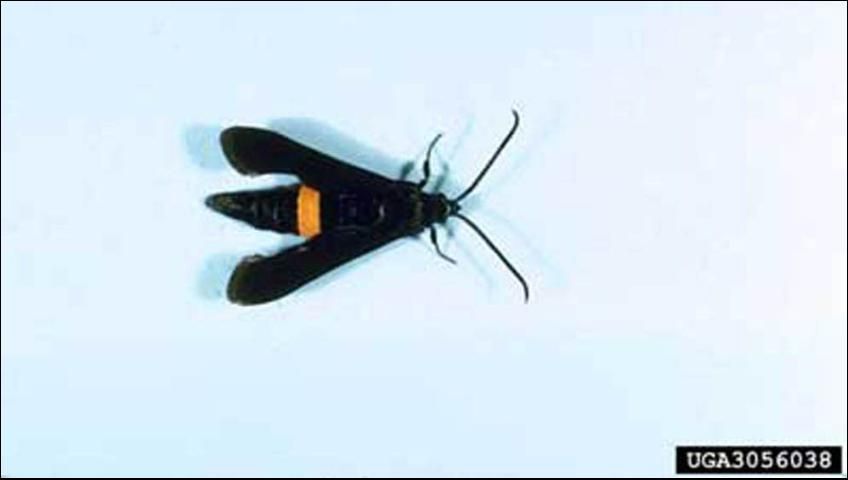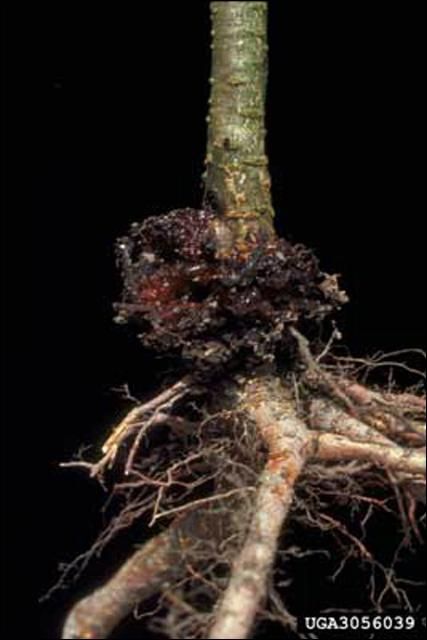The Featured Creatures collection provides in-depth profiles of insects, nematodes, arachnids and other organisms relevant to Florida. These profiles are intended for the use of interested laypersons with some knowledge of biology as well as academic audiences.
Introduction
The peachtree borer, Synanthedon exitiosa (Say), is a very serious agricultural pest. The peachtree borer and the lesser peachtree borer, Synanthedon pictipes, account for more damage to peach trees than all other insect pests combined. The peachtree borer can damage the tree in two ways: girdling and inducing plant pathogens to invade the weakened tree.

Credit: James Solomon. ForestryImages.org
Distribution
Peachtree borers are native to the United States. They are found throughout the United States and Canada.
Description
Larvae
Larvae vary from 1.25 to 3.5 cm (1/2 to 1 1/3 in) in length and are white with a brown head.
Adults
The adult moths are wasp-like in appearance. Adult females are dark metallic blue in color with opaque fore wings and clear hind wings. The wingspan is approximately 3.5 cm (1 1/3 in). The abdomen is encircled with one or two yellow bands on the fourth and fifth or only the fourth abdominal segment. The male is slightly different in appearance. The male is slightly smaller and more slender than the female. Unlike the female, both pairs of wings are clear. His wingspan is slightly smaller and measures about 2.25 cm (7/8 in). He also has a number of narrow yellow bands on the abdomen.
Life Cycle
The period of time required to complete a life cycle varies considerably throughout the range of the peachtree borer. It is reported that it takes two years to complete a life cycle in Canada and in a small percentage of populations in New York. Much of the United States including Texas and Nebraska has one generation per year. A partial second brood is present in Georgia. Florida, however, has two generations of peachtree borer per year. The adult female peachtree borer lays between 400 and 900 eggs on the trunk at the soil-line, or on weeds and surrounding litter around the base of the trunk. Peachtree borers have an extremely high rate of fertility, and about 97% to 100% of peachtree borer eggs hatch.
The hatched larvae bore into the trunk, large roots, or stems. The larvae only feed on live cambium and their feeding creates tunnels in the cambium. According to work done in New York, there are seven instar stages in the development of the peachtree borer. The larvae feed for 30 to 40 days at 80°F. Shortly before reaching maturity, the larvae enter dipause. The larvae feed for 10 days following dipause and enter a pupal stage that is approximately 20 days in length. Those larvae that are stressed will pupate and materialize as small adults and require a longer time to reach maturity. Pupae are usually found within 2 inches of the tree. Adults emerge from pupation between the hours of 8 AM and 1 PM. Within an hour females are ready to mate. More than 60% of the eggs are laid on the first day of adulthood. The lifespan of the adult male and female is about five days. Neither the males nor females will eat during their adult life.
Hosts
All stone fruits in the genus Prunus, which include peach, cherry, plum, prune, nectarine, apricot, and ornamental shrubs, are susceptible to damage by the peachtree borer. Unlike the lesser peachtree borer, the peachtree borer prefers healthy plants.
Symptoms of Infestation
One sign of infestation is massive amounts of oozing sap mixed with frass exuding from entrance holes on the trunk at ground level or lower branches of the tree. However, pathogens, mechanical injury, and other insects can also cause similar symptoms. Skins of pupa may be found coming out from the bark of the trunk. The grower will also experience a drop in yield. Branch dieback may also occur. If left untreated, most trees will die.

Credit: James Solomon. ForestryImages.org
Monitoring
Knodel and Agnello (1990) found that the Scentry wing trap ensnared more adult males than did the multi-pher (1–3) and delta traps. The level at which the trap is placed is also critical. The flight pattern of the peachtree borer is closer to the ground than the lesser peachtree borer. The pheromone found to work best at attracting adult males was (Z,Z)-3,13-Octadecadien-1-ol Acetate or Z,Z (ODDA). It was also found that this pheromone worked so well that it could be employed as a control mechanism in geographically isolated orchards. In these orchards, 100% of all males in the orchard were captured in the pheromone trap. The problem with this system is immigration into the orchard by gravid females from wild and cultivated host species.
Management
Cultural Control Methods
First, plant on an appropriate site. Destruction of alternate hosts such as wild varieties of stone fruits is not usually a viable option because of the distance that the adults will fly. It is also important to use an appropriate amount of fertilizer. Healthier plants, although more attractive to the peachtree borer, can sustain damage better than unhealthy trees.
Host Plant Resistance
Certain rootstocks have been found to result in a smaller number of adult peachtree borers. For example, "Siberian C" rootstock had 40% more emerging adults than "Lovell." Another study compared the incidence of adult emergence of different varieties, but nothing clear was indicated by the data.
Worming
Larvae can be removed using a knife. Care should be taken not to cut into undisturbed bark.
Chemical
A residual chemical insecticide can be applied to the trunk and the area of ground surrounding the trunk. The insecticide application should coincide with the hatching of the eggs. Follow label instructions.
Selected References
King, DR and HF Morris. 1956. Biologies of the peach tree borer and lesser peach tree borer in east Texas. Journal of Economic Entomology 49: 397–398.
Knodel JJ and AM Agnello. 1990. Field comparison of nonsticky and sticky pheromone traps for monitoring fruit pests in western New York. Journal of Economic Entomology 83:197–203.
Reilly, CC, CR Gentry, and JR McVay. 1987. Biochemical evidence for resistance of rootstocks to the peachtree borer and species separation of peachtree borer and lesser peachtree borer (Lepidoptera: Sesiidae) on peach trees. Journal of Economic Entomology 80: 338–343.
Smith, EH. 1965. Laboratory rearing of the peach tree borer and notes on its biology. Journal of Economic Entomology 58: 228–236.
Snow, JW, CR Gentry, and M Novak. 1985. Behavior and control of the peachtree borer and lesser pechtree borer (Lepidoptera: Sesiidae) in peach orchards permeated with (Z,Z)-3,13- Octadecadien-1-ol Acetate. Journal of Economic Entomology 78:190–196
White, T. 1985. Stopping the peach tree borer. Organic Gardening 32: 64–66.
Williamson JG and TE Crocker. Peaches and Nectarines for Florida. Circular 299-D. Gainesville: University of Florida Institute of Food and Agricultural Sciences.
Wohlers, V. 1990. Bored to death. American Nurseryman. 172: 76–78, 80, 82–89.